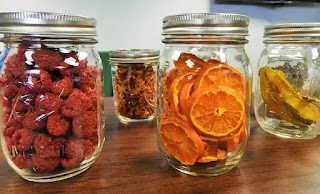Preserving Food for the Future: The Secrets of Drying Food
As we all know, food is one of our basic needs. However, as much as we would like to consume fresh food every day, it is not always possible. The solution? Food preservation! And one of the oldest and most effective preservation techniques is drying food.
Drying food has been practiced for centuries by various cultures, and it is still a popular preservation method today. This process involves removing the moisture from food, which makes it less hospitable to bacteria and other microorganisms that cause spoilage.
But why should we bother preserving food in the first place? There are many reasons why drying food is an excellent way to preserve it.
Firstly, dried food is easy to store. Unlike fresh produce, which can spoil quickly, dried food can be kept for long periods without refrigeration. This makes it ideal for stockpiling or for taking on long trips.
Secondly, drying food is a great way to reduce food waste. When food is dried, it can be stored for much longer, which means less food goes to waste. This is particularly useful if you have an excess of produce from your garden or if you are trying to save money by buying in bulk.
Finally, dried food is a healthy and nutritious option. Drying food preserves its nutrients, which means that dried fruits and vegetables are a great source of vitamins and minerals. Additionally, dried meat is a great source of protein and can be used in a variety of dishes.
Now that we know why drying food is so great, let's dive into the process of how to do it!
Step 1: Choose Your Food
The first step in drying food is to choose what you want to dry. Almost any fruit, vegetable, or meat can be dried, but some are better suited than others. Fruits like apples, bananas, and apricots are great for drying, as are vegetables like tomatoes, peppers, and mushrooms. Meats like beef, turkey, and venison can also be dried.
When choosing your food, make sure it is fresh and free from any bruises or blemishes. This will ensure that it dries evenly and doesn't spoil during the process.
Step 2: Prepare Your Food
The next step is to prepare your food for drying. This involves washing and slicing your fruits and vegetables, and seasoning your meat if desired. For fruits and vegetables, slice them into thin, even pieces to ensure that they dry evenly. For meat, slice it into thin strips against the grain.
Step 3: Dry Your Food
There are several methods for drying food, including using a dehydrator, an oven, or the sun.
Using a dehydrator is the easiest and most efficient method. Simply place your sliced food on the dehydrator trays, set the temperature, and let it do its thing. Dehydrators can be purchased at most home goods stores and are relatively affordable.
If you don't have a dehydrator, you can use your oven. Set it to the lowest temperature possible, place your food on a baking sheet, and leave the oven door slightly ajar to allow moisture to escape. It may take several hours for your food to dry completely using this method.
Finally, you can dry your food using the sun. This method requires a bit more effort and time, but it can be done with minimal equipment. Simply place your food on a clean, flat surface in direct sunlight and cover it with a mesh screen to keep out insects. It may take several days for your food to dry completely using this method.
Step 4: Store Your Food
Once your food is dry, it's time to store it properly. Store your dried food in airtight containers, such as glass jars or plastic bags with zip-lock seals. Make sure to label the container with the type of food and the date it was dried, as well as any other relevant information such as seasoning or special instructions for rehydration.
Dried food can be stored at room temperature for several months, but for longer-term storage, it is best to keep it in a cool, dry place such as a pantry or cellar. It is important to check your dried food periodically for signs of spoilage, such as mold or off-odors, and discard any that appear to have gone bad.
Tips and Tricks for Drying Food
- Use a mandoline or a food processor to slice your fruits and vegetables uniformly and quickly.
- Dip sliced fruits such as apples and pears into a mixture of lemon juice and water to prevent browning.
- When drying meat, marinate it in a mixture of spices and vinegar before drying to add flavor and tenderize the meat.
- To speed up the drying process, slice your food thinner and cut it into smaller pieces.
- Use a fan to circulate air around your food when drying outdoors to speed up the process.
Conclusion
Drying food is an easy and effective way to preserve your favorite fruits, vegetables, and meats. It is a great way to reduce food waste, save money, and enjoy nutritious and delicious food all year round. With a little bit of preparation and some patience, you can become a master of drying food and enjoy the benefits of this ancient preservation technique.
So, the next time you have an abundance of fresh produce or want to stock up on some healthy snacks, consider drying your food. It's a fun and rewarding way to take control of your food supply and ensure that you always have something delicious and nutritious to eat.
Labels: Interesting, science, Technology


0 Comments:
Post a Comment
Subscribe to Post Comments [Atom]
<< Home